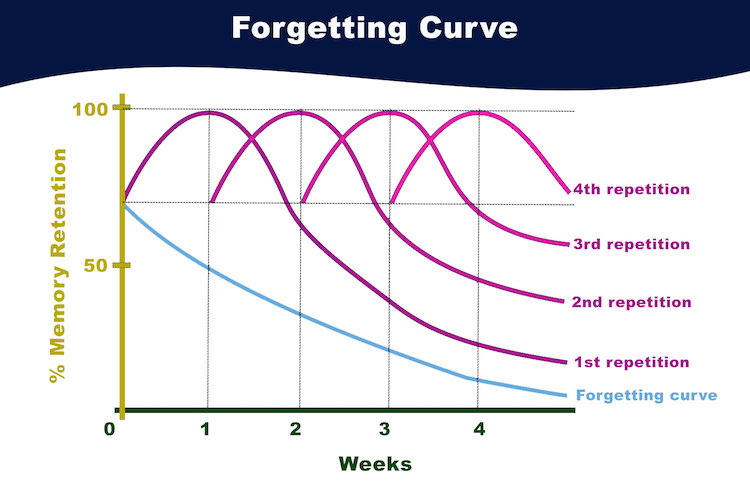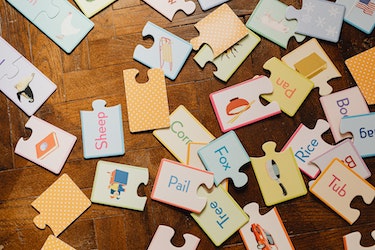Spaced repetition is a learning technique which is often practised with flashcards. This technique has been scientifically proven to increase the rate of learning and can be extremely beneficial to those who learn quicker from repeated exposure to information.
It works best when the information you are trying to learn is short and simple, which is why using flashcards is the most effective use of this technique. If the information is straightforward enough to fit on two sides of a flashcard, then there is a better chance of it being quickly understood and absorbed.
Spaced repetition isn't the most ideal studying technique to retain information that requires more creative interpretation or manipulation. It is typically used to memorize facts or figures.
Additionally, spaced repetition works better when the learner is attempting to learn a lot of information. For example, this technique is often used when trying to learn a new vocabulary or learn complex maths problems.
This has caused some criticism of the spaced repetition technique, as some people argue that the use of spaced repetition doesn't allow you to understand the topics at hand. However, you can avoid this by having a basic background understanding of the topic at hand, and simply memorising the facts and figures that relate to this topic grows your comprehension of the subject as a whole.
For example, if you are learning about the Civil War, simply remembering the dates of the battles and names of the soldiers won't result in your complete understanding of the war. However, if you already have background knowledge of the Civil War, and the nuances of its happenings, then memorising facts and figures provide you with a more in-depth understanding of the entirety of the topic.
The specific way that spaced repetition works is by having a stack of flashcards, and after a certain amount of time, introducing newer or more challenging flashcards to this stack. At the same time, older or easier flashcards are taken away from the pack. By replacing these flashcards, you are spacing out your studying by increasing the intervals between study sessions.
This technique works by utilising the 'spacing effect'. This effect is the opposite of 'cramming', as it builds on the theory that people learn much more effectively when their study sessions are spaced out, and they absorb information over a longer period. The information has a better chance of being stored in the brain and reduces the probability of forgetting information.
Infamous apps and websites utilise this technique, such as Quizlet or Duolingo, which regularly remind you of information that you've already learned to strengthen its presence in your brain.
Spaced repetition was popularised by the psychologist Hermann Ebbinghaus, who studied the science behind memory. He wanted to find out the most effective way to memorise a lot of information in the shortest amount of time.
During this time, he also plotted 'the forgetting curve'on a graph, which is the rate at which humans forget information. Whilst the theory is highly simplified, 'the forgetting curve'is a generally accurate representation of how memory works.
Typically, the graph shows that humans tend to forget half the information about newly learned knowledge in a matter of days. If not relearned, 80% of the information is completely lost after a few weeks.
As stated before, this theory is extremely simplified, mostly because memory is not as straightforward as simply losing information forever.
The reality is all information that humans consume is stored in the brain. However, just because the memory is in your head doesn't always mean that you can access it. This explains why every now and again you remember random things from years before seemingly out of nowhere.
There are two different components to memory recall:
Storage strength:
Storage strength is the stronger of the two components. Information that has been acquired is always stored in the brain, but the brain deems different information with different importance. Information that is deemed more important is easier to remember, but information that isn't as important may require more effort to recall.
Retrieval strength
On the other hand, unlike storage strength, retrieval strength can become weaker, and often fades when you don't regularly practice retrieving memories.
This is why spaced repetition is a great tool for increasing memory recall. Storage strength can only increase through repeated recall or use, and retrieval strength can be increased with practice.
Your memories aren't 'lost', your brain is just struggling to find it among all the other information in your brain.
Repeatedly exposing yourself to this information using spaced repetition strengthens your brain's ability to access the information. Additionally, the use of flashcards makes the process even easier as it provides a prompt, allowing your brain to access the answer a lot easier.
The most effective way of using spaced repetition with flashcards is by using them every other day over the period of a week, or a few weeks.
You want the information to be stored in the long-term memory part of the brain – the hippocampus. The hippocampus sorts the memories for us, and by repeatedly reintroducing the memories into your brain they pass through the hippocampus multiple times.
This strengthens your brain's familiarity with the information and helps the hippocampus create and reinforce associations with the information that make recall a lot easier. When you reintroduce the information on multiple different occasions, the hippocampus eventually stops strengthening these associations, and the information is stored in the long-term memory.
The most effective length of time to reintroduce the information to your hippocampus can be different for different people. However, studies suggest that reintroducing information 4 different times over the period of a month is optimal for memory recollection:
- First repetition: after one day
- Second repetition: after one week
- Third repetition: after 16 days
- Fourth repetition: after 30 days
If you use this schedule for your spaced repetition technique, then the information will be stored in your brain as a full-time memory, and you will be able to recall this information easily.
The best way to keep track of the different topics that you are attempting to learn using spaced repetition is by creating a spreadsheet. You list the topics in one column of the spreadsheet and each time you go over the topic you write the date next to it.
You should only write the date in the column if you have actively used the spaced repetition technique – reading a chapter in a textbook is not enough.
Spaced repetition only works if you are actively recalling information. Keeping a log of these dates means you can ensure that you are using the most effective schedule that optimises your memorisation of this information.
You can also use the spreadsheet to colour code each date depending on how easily you could remember the information. This means you can actively see which topics you need to improve on, or which ones you are stronger in, thus giving you an idea of which flashcards to reintroduce to your spaced repetition study session.
People who use spaced repetition as a learning technique have been scientifically proven to have much higher scores in tests and exams. This is still true even if people often gave the wrong response when studying with spaced repetition.
This is because the use of feedback or correction, even if you initially got the answer wrong, still strengthens the associations related to the information in your hippocampus.
Spaced repetition is an outstanding studying technique because you can do it anywhere at any time. All you need is your flashcards, and a free few minutes to practice! After only a week, you can learn all the information you need to ace any test or exam, and you're well on your way to success!
You don't even need to use physical flashcards for this studying technique. There are countless websites, apps, and computer programs that use the spaced repetition technique, and also give you little hints and reminders to optimise the studying process.
Whilst this studying technique shouldn't be your only studying technique, it's a great place to start. It's the best way to supplement your understanding of topics by memorising facts and figures that relate to them, and it's a relatively easy and pain-free process.
Using spaced repetition a few minutes a day will make sure that all words you use in the technique will never be neglected if you use it right.
Read more about other effective memory techniques such as mnemonics, acronyms and chunking.













